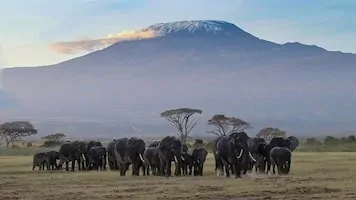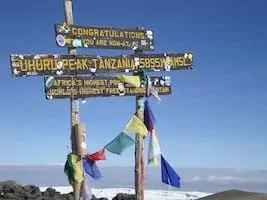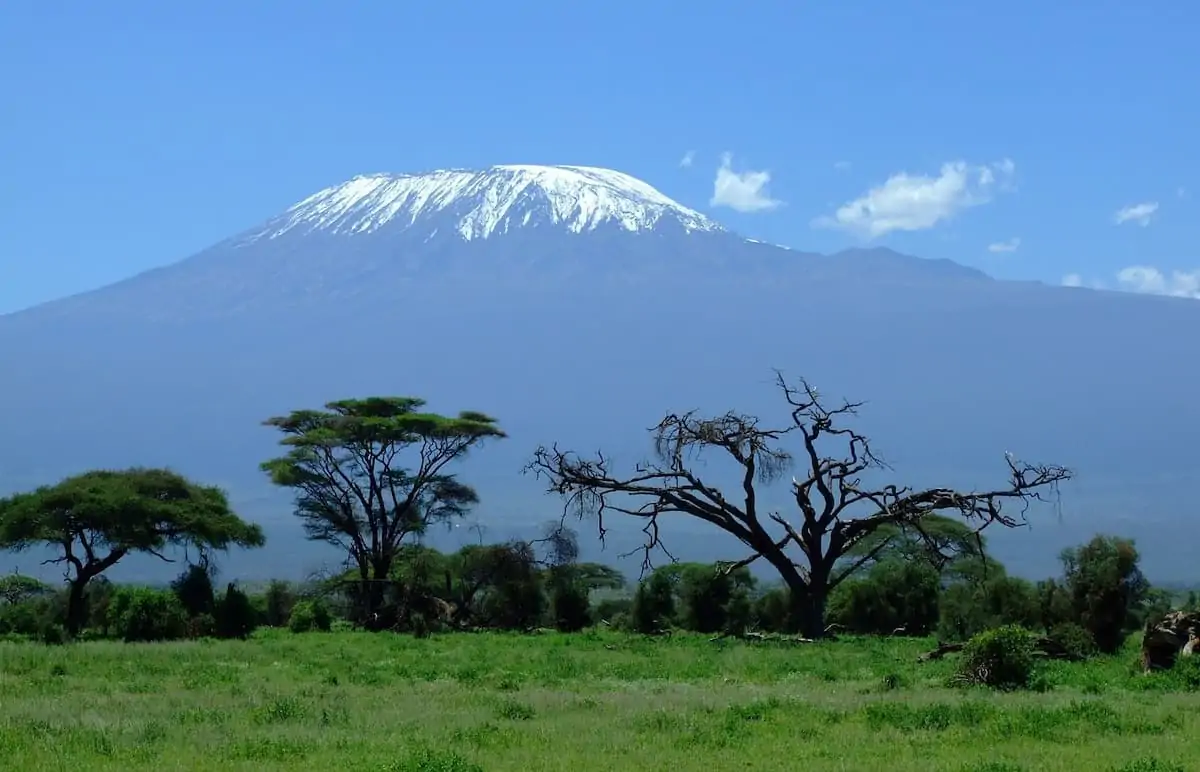I spent a year working in Colorado. In Colorado you can’t help but be drawn to the beauty of the mountains. Eventually I started climbing those peaks (called the Fourteeners, as they are over 14,000 feet high) in my spare time. I hadn’t even thought about Mount Kilimanjaro at that point.
At the same time I started reading all of the books I could find on mountain climbing. One in particular, the “Seven Summits“, by Dick Bass and Frank Wells, with Rick Ridgeway, really caught my attention. It tells the story about these guys who got the idea to climb the highest summit on each continent.
By the time I had finished the book I got the idea in my head that I wanted to climb Mount Kilimanjaro in Africa. That became the start of an adventure of a lifetime.
Laying the Groundwork
When I first got the urge to climb mountains in Colorado I had no experience whatsoever. I had no skill and no ability other than desire and determination. I did a lot of research and decided that before I was going to try to climb the highest peaks I was going to have to train and build up my abilities.
I first climbed a relatively simple, smaller peak at about 7000′ of altitude. The 6 mile trek proved exhilarating. I was able to easily cover the distance and the altitude. With that feat accomplished I then tackled a peak of increasing difficulty at over 10,000′ of altitude and a 7 mile trek. It took me longer and I had to pace myself but the sense of accomplishment, let alone the views, when I arrived at the top, was incredible.
I now felt I was ready to tackle the Fourteeners, the 14,000′ peaks. There are 58 of them with a wide range of difficulty and accessibility. I studied them all and decided which ones I wanted to tackle first. The major considerations for me were going to be stamina and endurance as I was going to be dealing with a much higher altitude, longer distances, and difficult terrain.
Planning, researching and preparing were vital steps to ensure that I was going to be successful in achieving my goals.
I decided on one mountain as my first Fourteener attempt, for which there was an adjacent mountain connected with a relatively short saddle, named Grey’s Peak and Torrey’s Peak. I set off early in the morning. The distance was about 8 miles at a higher altitude which certainly took me longer. But when I arrived at the top of Grey’s Peak I could see Torrey’s Peak next to it, so I proceeded to traverse the saddle and I got to the top of Torrey’s Peak as well. What a great start!
From there I proceeded to pick mountains to climb of increasing difficulty over the ensuing months. In a short time I had climbed 10 peaks. Long’s Peak proved to be the most difficult. It was the longest at 15 miles and there were more technically difficult sections. And for the first time it took me just as long to get down from Long’s Peak as it did to go up. Usually I was able to descend much faster than I took to go up. By the end of the trek I was absolutely exhausted. It was a lesson, and reminder, that getting to the top is only half of the goal. The real achievement is to safely get back down again.
My final attempt was on Sherman Peak. As I proceeded to climb I could hear thunder in the distance and I could see a storm coming in. At one point I dropped my backpack and started sprinting up towards the peak which I could see. But I soon stopped. I could now see lightning and despite my desire to reach the top I didn’t come here to die on the side of a mountain. I quickly turned around and descended to shelter and left as the storm completely engulfed the mountain.
It was another lesson. Don’t be so focussed on achieving your goal that you ignore all that is going on around you. Be aware of the risks. You can always regroup and reengage later.
And as my time in Colorado came to an end that’s when I really set my eyes on the prize: Climbing Mount Kilimanjaro.
On To Africa
I studied climbing Mount Kilimanjaro in greater depth. I read more books, more stories, and did more research on line. I was driven by the desire to go and climb that mountain. I gave myself 6 months to get ready for the trip.
Interestingly I learned that while it is one of the least technically difficult of the Seven Summits it is by no means a stroll in the park. There are world class athletes who have failed to reach the peak for various reasons. I am in no way an athlete of any kind by I knew there were lessons to be learned from the experiences of others. Approximately half of the people who attempt to climb Kilimanjaro fail to reach the summit.
I knew that I would need to train. My time in Colorado had given me a period of acclimatization to higher altitudes that would do me well. Still Mount Kilimanjaro, at 19,308′ was almost a mile higher than anything I had climbed in Colorado. That was a big variable. Would I be ok at that higher altitude? I would have to train to ensure that I was as prepared as possible.
I also decided that if I was going to do this I wanted to do it the most challenging way possible. I did not want to take the easiest route. So I decided I would take the Machame, or “Whiskey”, route which was considered one of the more difficult routes. If your going to set your goals you might as well set them as high as possible.
On top of that Mount Kilimanjaro has 5 different climatic zones ranging from Cultivation to Rainforest to Moorland to Desert to Arctic. I would traverse these in the 5 days it would take to go from the trail head to the summit. That is a lot of variability in conditions to deal with.
My physical training included a variety of weight and cardiovascular training. I knew that I needed to put in a lot of hours to be ready. The long route, the higher altitude, and the greater difficulty were more than I had ever faced before.
My mental training focussed not only on greater research but also on reinforcing long held beliefs in goal setting, visualization, persistence and perseverance. When circumstances presented themselves my attitude would make the difference between success and failure.
In no time at all 6 months had elapsed. It was time to head to Africa.
The Highest Mountain in Africa
When I arrived in Africa I was picked up by my guide. After a night of sleep we started the next morning and drove to the trail head. Along the highway we could see Mount Kilimanjaro in all its magnificence. It is the tallest free standing mountain in the world. I couldn’t wait to get started.
I had brought the range of clothing I would need for the range of climatic conditions I would be in. Starting at the trailhead was somewhat chaotic with dozens and dozens of people aspiring to make their way to the top.

Before long as I proceeded up the trail and through the forest the number of people spread out. The faster, more prepared people moved on ahead whereas the slower folks lagged behind. Walking through the rainforest was fascinating with the trail frequented by tree roots, swampy and muddy areas and rocks. At the end of the first day I had ascended to about 8500′ of altitude. The camp site had a lot of people in it.
By the end of the second day I had advanced to over 11,000′, as high as I had been in my early days of climbing in Colorado. I was completely fine at that altitude. The campsite had fewer people than on day one as people veered off to catch various trails.
The third day saw the disappearance of most vegetation. We ended up camping on the rocks at the Lava Tower camp site. Very few people had decided to come this way. I was now sleeping at about 14,000′, the highest I had ever been in my life. I felt good and physically up to the task.
The next day wasn’t a long trekking day. And we advanced up to about 16000′. The distance wasn’t as far and the trek took only 4 or 5 hours. But the main goal was to spend time at that altitude and acclimatize. The camp was set up on a glacier. The next day was summit day. I felt as ready as I had ever been!
Summit Day
We started at 1:00 am. There were approximately a dozen other people going up the same route at the same time. There was so much snow on the mountain at that time that we had to “post hole” our way up. That is the snow was well above our knees so each step was slow and deliberate. It was difficult and strenuous but we persevered.
As we got over the ridge of the crater we had achieved a height of about 18,700′. It was vastly higher than I had ever been. There was still another 640′ vertical feet to go to the summit.
Everyone rested for a short while before the final summit push. My guide however (everyone is required to have a guide on Kilimanjaro) wasn’t feeling well. He had climbed the mountain hundreds of times but he was showing signs of altitude sickness.
As everyone climbed the last stretch the snow was even deeper. Now it was waist high. After going up about 100′ my guide and the other guides said that we couldn’t go up any further. There was too much snow.
Most of the people decided to turn back and start their descent. A few people decided to forge straight up. As I thought about the decision at hand I knew that I didn’t come all this way and do all of this planning and preparation only to turn around at the very end.
I asked my guide and another guide if there was another way up. They told me that on the opposite side of the crater I could connect with another trail which would lead me to the summit. That became my new plan.
I walked to the other side. My guide followed me but he was clearly not feeling well and fell further and further behind. As I reached the other side the few remaining climbers who went straight up were coming down having successfully reached the summit. They told me it was about a 15 minute trek up to the summit.
By this point it was almost 11 hours since we started. I double timed it up the remaining stretch at arrived at the summit at 12:00pm. I was the last one on the summit that day. I took my own selfie with the summit marker in the background, long before “selfie” was even a word.

I did it!
I was ok at that altitude. One mile higher than I had ever been before. I was in good condition. And I achieved my goal, or atleast half of my goal. Now I had to get down.
I rejoined my guide further down the trail and we started the descent down Mount Kilimanjaro. As it happens most of the time the descent was a lot quicker than the ascent. By 7:00pm we arrived at the camp site where all of the climbers met up.
I collapsed in my tent. After 18 gruelling hours I was physically and mentally exhausted. I had achieved my goal. The planning, preparation, physical training, and mental training had all paid off.
Even my guide, who was exceptional and who had summited hundreds of times, was not able to summit on this day. The very best can have an off day. Which is all the more reason to prepare in every way possible for any eventuality.
Mount Kilimanjaro
As I reflect on my adventure of almost 20 years ago I take a lot of pride in the accomplishment. It was an incredible opportunity born of an ambitious goal enabled by a lot of physical and mental preparation and deployment of a variety of skills and techniques.
Not everyone reaches the summit, whether that be in climbing Mount Kilimanjaro or any other goal you set for yourself. That in no way is necessarily a reflection of their preparation or skill. Circumstances can sometimes conspire to thwart our plans.
The key is to set far reaching goals, persevere, and perform all the necessary steps to achieve your goals with a positive and unrelenting attitude and focus. These are great lessons for any aspect of your life.
Remember to reach for your mountain top, whatever that may be! As the saying goes “If at first you don’t succeed try, try again.” You won’t believe the view, the feeling of accomplishment, and the confidence you will gain which will lead to setting even higher goals.


Great post with nice narrative information. Thank you very much for sharing.